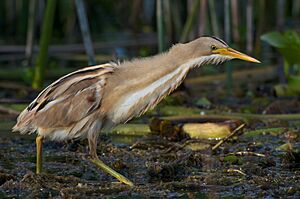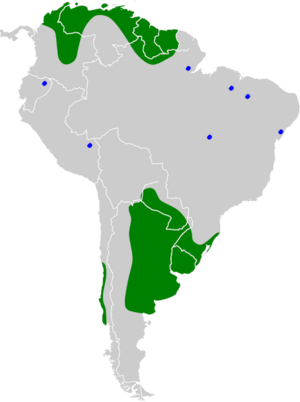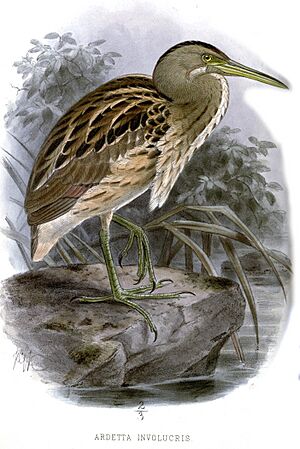Stripe-backed bittern facts for kids
Quick facts for kids Stripe-backed bittern |
|
|---|---|
 |
|
| Conservation status | |
| Scientific classification | |
| Genus: |
Ixobrychus
|
| Species: |
involucris
|
 |
|
The stripe-backed bittern (Ixobrychus involucris) is a small bird. It belongs to the Ardeidae family, which also includes Herons and Egrets. You can often find these birds near fresh water. They live in swamps, marshes, and along lake shores and streams.
Stripe-backed bitterns live in many places. They have populations in both northern and southern South America. Scientists are learning more about these birds. However, we still don't know many details about their lives. This is because they are harder to study than similar birds like the least bittern.
Contents
What is a Stripe-Backed Bittern?
The stripe-backed bittern is part of the Ixobrychus group of birds. This group has nine types of small wading birds found all over the world. A scientist named Vieillot first described this bittern in 1823. He gave it the scientific name Ixobrychus involucris.
How to Spot a Stripe-Backed Bittern
Stripe-backed bitterns are quite small. They are usually about 28 to 35 centimeters (11 to 14 inches) long. Their backs are pale brown with black and yellowish-beige stripes. These stripes also run along their wide wings. The colors on their back and wings blend together. This helps them hide.
Black stripes continue onto their darker brown head. Their belly is lighter brown with white stripes. Their beak can be pale green or orange. It's hard to tell male and female stripe-backed bitterns apart. Young birds are also not well described. This makes it tricky to know their age or gender. It's even hard to find them in the wild!
These birds often stand very still. They "freeze" to watch their surroundings. This helps them hunt for food. If they feel threatened, they point their neck and beak straight up. This makes them even harder to see. Stripe-backed bitterns usually live alone. You might sometimes see them in pairs, but rarely in groups.
How is it Different from Similar Birds?
The stripe-backed bittern can look a lot like the least bittern. But there's a main difference. The least bittern has a dark back with no stripes. Its wings, however, are patterned. Least bitterns also have reddish-brown colors on the sides of their head. Female least bitterns have this color on their neck too.
Where Do They Live?
Their Home Range
Stripe-backed bitterns live in different areas, but they are spread out. You can find them on both sides of the Andes mountains.
- Northern Population: These birds live in parts of South America. This includes Colombia, Venezuela, Guyana, Suriname, French Guiana, and the island of Trinidad.
- Southern Population: This group lives in central and southern South America. They are found in Paraguay, Uruguay, Argentina, Chile, southern Brazil, and Bolivia.
In recent years, they have also been seen in northeastern Ecuador and southeastern Peru.
What Kind of Habitat Do They Like?
Stripe-backed bitterns prefer places with fresh water. They love areas with lots of plants. This includes reed beds, swamps, rushes, lakes, and mountain streams. They also live in marshes and even rice fields. These wet places are important for finding food and building nests.
Behavior and Life Cycle
What Do They Eat?
More than half of what stripe-backed bitterns eat are insects. They especially like insects like dragonflies, beetles, and grasshoppers. The rest of their diet includes small fish, crustaceans (like crabs), and arachnids (like spiders).
These birds are active during the day. They hunt most in the early morning or in the afternoon. They usually rest around noon and at sunset. They often feed alone or sometimes in pairs. They have been seen feeding at night, but this is rare.
Reproduction and Nests
Scientists don't know a lot about how stripe-backed bitterns reproduce. These birds are not strong fliers. They only fly short distances. Because of this, their nests are not found high up in trees.
Stripe-backed bitterns build small nests. They use tightly woven reeds and stems. Their nests are found just above the water level, hidden among the reeds. We don't know how long their eggs take to hatch. Also, their breeding seasons seem to be different depending on where they live.
Unique Eggs
The eggs of stripe-backed bitterns are quite special. Birds in the Ardeidae family usually lay pale blue eggs. These eggs are often oval or round. Their outer layer is clear, letting you see the blue or white inner shell.
However, stripe-backed bittern eggs are different. They have pale blue inner layers. But they are covered by a clear green outer layer. Scientists have seen this many times. Yet, they still don't fully understand why these birds have such unique egg colors.
How Do They Communicate?
Stripe-backed bitterns make distinct sounds. These sounds can help you know if they are nearby. They make low-pitched "ooks" or gargling sounds.
When they want to protect their territory or warn others, they make four low "huu" or "ook" notes. After that, they make a faster, higher-pitched "g'u'u'u'a'a" gargle.
Conservation Status
The stripe-backed bittern is not considered to be in danger. It has a wide range and a large, stable population. Because of this, they don't get much special attention for conservation. They are not a priority for programs that protect endangered animals. Their population is healthy and is not expected to become vulnerable soon.



